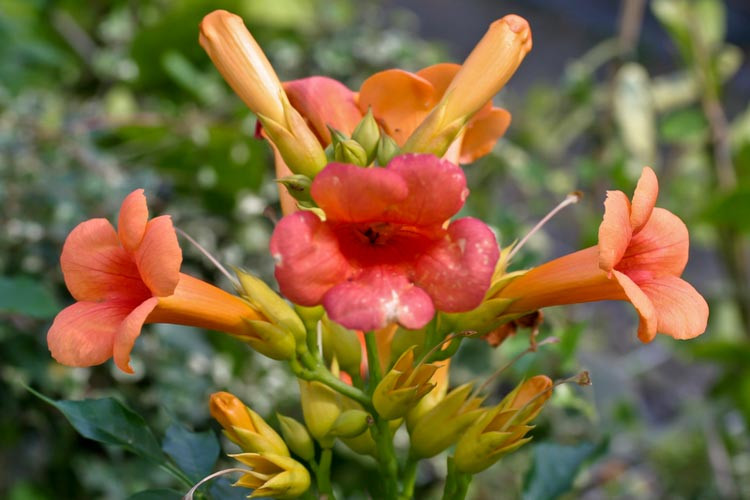People love to climb the trumpet vine, or Campsis radicans, because it has beautiful orange-red trumpet-shaped flowers that hummingbirds love. The species plant can be too aggressive, but there is a beautiful cultivar called Campsis Indian Summer that has the same flowers but grows more slowly and is more polite.
Campsis Indian Summer, which is also called Campsis tagliabuana ‘Kudian’ and Campsis ‘Kudian,’ is a woody vine that loses its leaves in the fall. It is in the Bignoniaceae family. A cross between Campsis radicans and Campsis grandiflora was most likely what it was. This type of trumpet vine grows to be 12 to 15 feet tall and 3 to 5 feet wide when it’s fully grown. It climbs by aerial rootlets and attaches itself to structures.
The dark green leaves are compound and odd-pinnate, meaning they are made up leaflets arranged opposite each other along the midrib. There are usually 7-9 elliptic to oblong leaflets up to 4 inches long. In the fall, the leaves turn a nice yellow.
Campsis Indian Summer blooms from July to August with groups of bright orange-red trumpet-shaped flowers that are about 3 inches long. The flower’s throat is reddish and the petals are yellow-orange. They bring in hummingbirds and add a bright splash of color to the summer.
Growing Conditions for Campsis Indian Summer
This trumpet vine grows well in full sun to partial shade. It adapts to a wide variety of soil types and pH levels. Campsis Indian Summer prefers evenly moist soils but is drought tolerant once established. It does well in USDA plant hardiness zones 4-9.
Provide a very sturdy structure for the vines to climb. A trellis, fence, or wall works well. Cut back stems that are too long in late winter to keep growth in check. Pruning trumpet vines doesn’t have to be done often, but it can help stop them from spreading too much.
Advantages of Campsis Indian Summer
There are several reasons why Campsis Indian Summer makes an excellent addition to gardens:
-
Less aggressive growth – Unlike the species trumpet vine which can spread rapidly and take over areas, Campsis Indian Summer is better behaved. It has a lower profile and is less invasive in the landscape.
-
Long bloom period – The flowers bloom for months, starting in summer and lasting into early fall. This provides an extended period of color.
-
Attracts hummingbirds – The red trumpet flowers attract hummingbirds, which is a benefit for gardens.
-
Tolerant of heat and drought – Once established, this trumpet vine handles heat and drier conditions quite well Its drought tolerance makes it a good choice for xeriscaping.
-
Adapts to various soils – Campsis Indian Summer grows well in different types of soil, including clay, loam, sand, chalky, and alkaline soils.
-
Less maintenance – While regular pruning helps keep growth under control, overall Campsis Indian Summer is lower maintenance than the species.
-
Great for walls or fences – The vining growth habit makes it perfectly suited for growing on walls, trellises, arbors, or fencing.
Potential Drawbacks
There are a couple potential drawbacks to consider:
-
It still spreads faster than some homeowners would like. Careful placement and pruning is required to keep the trumpet vine from spreading out of bounds.
-
The vine produces aerial rootlets that cling very tightly. Take care not to grow it directly on painted or delicate surfaces which could get damaged when removing vines.
An Excellent Flowering Vine
With its abundant orange-red blooms that attract hummingbirds and butterflies all summer, Campsis Indian Summer trumpet vine delivers visual impact to gardens. Its heat and drought tolerance makes it ideal for hot, dry areas of the landscape. Place this vine accordingly and prune as needed to keep growth under control, and you’ll enjoy this flowering vine for years to come.

Campsis ‘Indian summer’ and wildlife
Campsis ‘Indian summer’ has no particular known value to wildlife in the UK.
Trumpet Vine – BEWARE this Hummingbird Magnet has a Dangerous Side – Why grow Campsis Radicans
FAQ
Is the Indian summer trumpet vine invasive?
‘Indian Summer’ is a charming hybrid between Campsis radicans (American Trumpet Vine) and Campsis grandiflora (Chinese Trumpet Vine). It is a more compact and manageable Trumpet vine which is reportedly less invasive than the species.
Where is the best place to plant a trumpet vine?
The best place to plant trumpet vine is a sunny location with well-draining soil, ideally away from structures like your house or valuable plants, as it can be invasive.
What are the cons of trumpet vines?
Toxicity. Trumpet vine’s sap has a skin irritant that makes some people and livestock itch if they come into contact with it, hence one of its common names: cow itch vine.
Do you cut back trumpet vine every year?
Pruning should be done in the late winter or early spring. For mature plants, trumpet creeper tolerates heavy pruning to control its spread and maintain a desired size. Prune annually, spur-pruning lateral shoots back to within two or three buds of the main stems. Remove weak and diseased growth.
